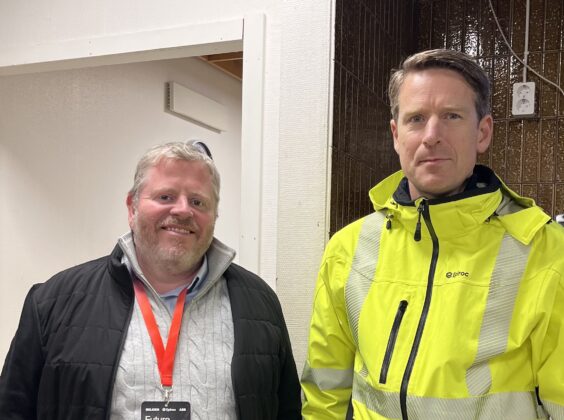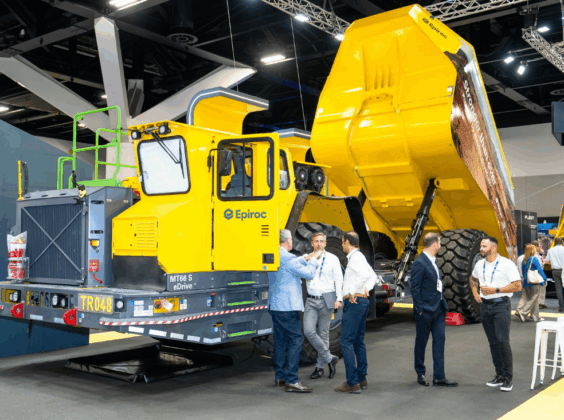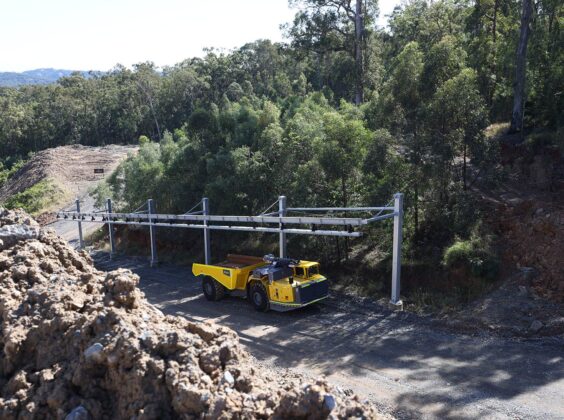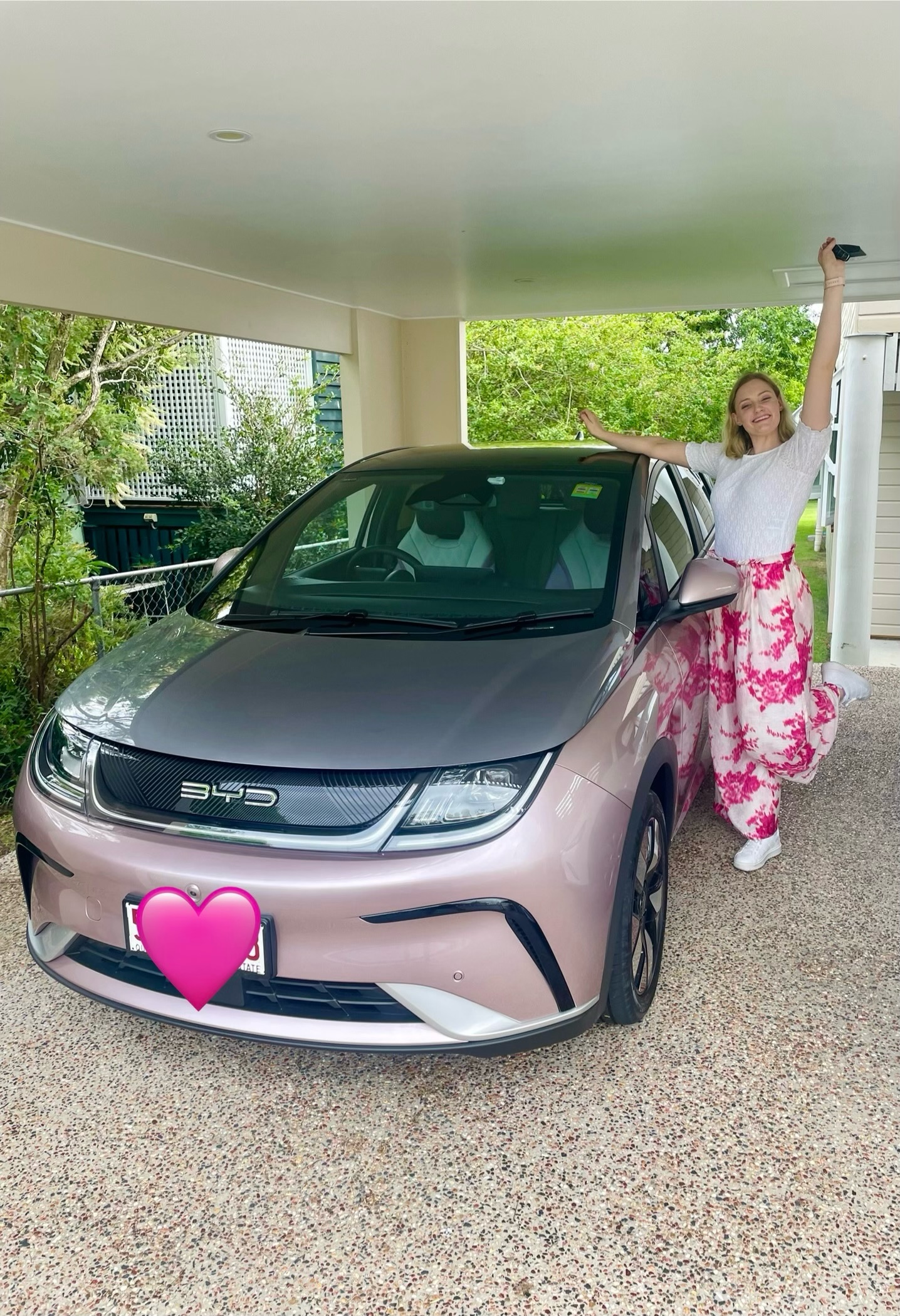IM Editorial Director Paul Moore recently had the opportunity at the completion of the MT42 battery trolley system at the Rävliden project, an extension of Boliden’s Kristineberg mine, to meet Mattias Pettersson, Global Portfolio Manager for Loaders and Trucks at Epiroc to discuss the electric transition, diesel electric machines, and autonomy progress in a wide ranging interview
IM Editorial Director Paul Moore with Mattias Pettersson, Global Portfolio Manager for Loaders and Trucks at Epiroc

Q: The 5 km project under commissioning at Rävliden combines an innovative battery trolley system using four Epiroc battery-electric trolley trucks (Minetruck MT42 SG) combined with three battery-electric Scooptram ST18 SG loaders and two battery-electric Minetruck MT42 SG trucks in the stoping area – it will be one of the world’s most electrified and therefore green mines, using hydropower. But this is a first mover project – how do you see the global market evolving across different technologies and demand levels?
MP: Because the market differs between mine and customer types and preferences, relative willingness to invest in electrical infrastructure; and as you say access to green power, we have to be in a position to have solutions for all sets of customers. That includes those wanting the traditional diesel machines, and this demand will continue to be there for many years to come. Then we have the BEV early adopter, leading edge customers, of which Boliden is a great example – and you have everything in-between, which includes customers looking to use our electric drive solutions such as our new Minetruck MT66 S eDrive. Of course for Epiroc, it is a challenge for us to be able to support all of these markets at the same time during what we believe to be a transition period. At Epiroc we remain fully convinced that one day we will only have electric vehicles in underground mining, whether that is battery, battery with trolley, or some other all electric option. And that is because the benefits are great, from zero emissions to zero particulates, noise and vibration reduction, cuts in ventilation costs, better efficiency, improved acceleration on grade – the list goes on. Actually the number one challenge in meeting interim demands for different powertrains isn’t our production capacity – as particularly in the generation we are in right now, we have developed the models to have as much component and design commonality as possible including the cab and most of the frame and chassis, including the axles and transmissions. We replace the engine with electric motors and replace the fuel tank with the battery. It brings advantages to our supply chain and to our ability to support the customer. However, looking to the future and a more dominant BEV market in mining – we will introduce a new, more purpose built, from the ground up design for our electric machines; as a natural step in investing in the future. That said, the current generation of electric models, as well as the diesel-electric options we already have and are developing, are a great step for the mining industry’s transition.
The Epiroc MT66 S eDrive on show at IMARC 2025 in Sydney – the model is equipped with a John Deere 6180C 18-litre Stage V engine, four 420 kW electric wheel motors and two 420 kW generators

Q: What is the current status of your diesel-electric machine line-up and what has driven that segment?
MP: Some of this has been driven by our large underground mining contractor and major mining customers in Australia – for example our development of the Minetruck MT66 S eDrive together with Gold Fields; and our diesel-electric Scooptram project with Byrnecut. For short to medium contracts and/or shorter mine lives, these customers need maximum flexibility and agility, and to go straight to a fully electric shift mine is a big CAPEX decision, as it comes with significant investment in charging and/or battery swapping stations or even a trolley line. So for now, they are not yet ready – and the contractor market in Australia is very strong. But it is important to remember it is still another step in that transition to all electric operations. We have built two Minetruck MT66 S eDrive units – the first we displayed at MINExpo 2024 and this returned to Orebro in Sweden for extensive testing. The second unit, which has been nicknamed ‘Matilda,’ is now in Australia, and will begin field trials at Gold Fields’ Granny Smith mine very soon. This will follow our exhibiting of the machine at IMARC in late October – then before it goes to the customer we will take the unit to a quarry site in the Perth area to allow other potential customers to get familiar with it, as the interest has been huge. And the results from the model have been impressive in our testing at our test mine in Sweden – including effortlessly hauling 66 t of material up a 14% incline at speeds of up to 11 km/h.
Q: So can you provide a rundown of the current available range of machines?
MP: In the Material Handling range, we offer today the battery-electric Minetruck MT42 SG plus Scooptram ST10 G, ST14 SG and ST18 SG on the loader side. The larger Minetruck MT66 S eDrive is our diesel-electric model, and thanks to the electric drivetrain, it is prepared to be built as a battery version. But the timing and demand level would need to be right. Today most applications for these very large trucks involve long decline ramp haulage and in this scenario, a full battery solution without trolley is still not competitive. With a trolley system, such as we have at the Rävliden extension in the Kristineberg mine, a battery MT66 could still be an option. We could build one today if a partner customer wanted to go ahead with it. We know what is involved and would just have to scale up. For our loader line-up, you mentioned our work with Byrnecut, with whom we are partnering on a more purpose-built electric drivetrain for the next model in our plans, which will be the first in our next generation range. We can’t reveal more information yet, other than that the first one will be a diesel-electric version and it will be designed to later accommodate an all battery option. As we stated when the MOU was first announced in 2023, it will have more optimised hydraulics, and a modular design to accommodate for different energy sources. Like other models in Epiroc’s Smart series that are designated SG, the new Scooptram loader will be equipped with Epiroc’s Rig Control System (RCS), making it automation ready.
Q: What is the plan for the electric transition at the other end of the scale in smaller trucks and loaders and is there a demand there to meet yet given the ROI may not be as rapid as with the large machines? And given many of them are operated by smaller mining companies with less access to capital?
MP: We have electrification plans for all of our truck and loader models – in alignment with meeting our stated aim of having a full all-electric lineup by 2030. For us it has just been a matter of prioritising the order in which we do it. We do already today have a 10 t electric loader option, the Scooptram ST10 G, which is based on the reliable Scooptram ST1030 and also combines our proven electric drive train and battery system. We also offered the ST7 Battery previously, but this was using an older design so we are updating it in line with our other current generation machines like the ST14 SG and ST18 SG. Below that we also have the 4 t loader – so we will have a battery versions of this as well. We still offer EST cable-electric versions of our 3.6 t, 6 t and 10 t loaders, which already give customers an electric option while this development is ongoing. Then on the truck side one of our most popular models worldwide is the Minetruck MT436B, a 32.6 t model in both standard and the MT436 LP low profile version. Plus, we have a diesel version of our smallest 22 t Minetruck, the MT22. We also have the Minetruck MT54 between our MT42 and MT65/MT66 models. We have come far on our electrification journey that goes hand in hand with our customers’ sustainability agendas.
Q: For trolley, will the DC-DC configuration you have used for the Ravliden project together with ABB and Boliden become the standard one? What about potential AC-DC or DC-AC system; and about trolley solutions for lower profile headings? And the cooperation project with BluVein on the slotted rail MT42?
MP: The easiest option for us and our customers, would be to have one standardised trolley system globally. Eventually we may get there, but for now we have to keep our options open to see how the underground trolley market evolves; and to allow to get experience with all the different potential scenarios you mention. Today we are supporting a pantograph on the Minetruck MT42 Trolley truck using ABB’s DC-DC converter, HES880 inverters and AMXE motors in the set up we have at Ravliden. This configuration may change for the next project wherever that will be. Another option could be a similar solution as the Kiruna trucks which are still operating in Canada. There is also the factor that some markets do not allow live powerlines at all, so the BluVein1 system may be more applicable in these situations, as there the conductors are protected in a slotted rail. That system along with our battery-electric Minetruck MT42 and JTMEC’s substation will soon be fully demonstrated at BluVein’s proving grounds in Brisbane, Queensland.
Preparations are underway for a full technology demo of the BluVein1 slotted rail system in Queensland using a battery Epiroc MT42 with JTMEC substation

Q: Finally, where does Epiroc autonomy stand today with regard to your diesel and electric models?
MP: It was natural, as with other OEMs, that we developed and proved our autonomous haulage for both loader and trucks in the diesel machines first, which we have done with our Deep Automation solution at a number of sites with our loaders including LKAB Kiruna, Newmont Cadia, Boliden Neves Corvo and others. For trucks in July, we announced that our first autonomous Epiroc MT65 S was working at Agnico Eagle’s Odyssey gold mine in Quebec which joined already autonomous Minetruck MT42 S trucks and Scooptram ST18 S loaders. For electric machine autonomy, at Ravliden work is well underway to introduce automation to the full fleet in partnership with Boliden in 2026, and it is already being used on the battery-electric Scooptram ST18 SG loaders in the stoping area. For automating the trolley trucks, we are just finalising a few aspects of the system such as in relation to raising and lowering of the pantograph. From the same operator station it is also possible, with our technology, to control and monitor both autonomous loaders and trucks.




